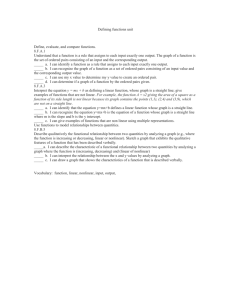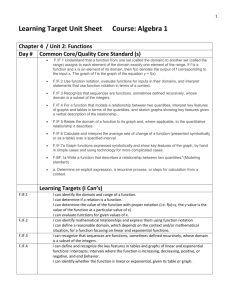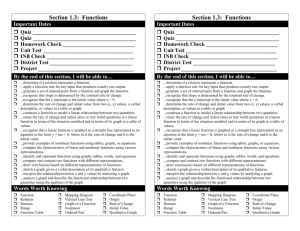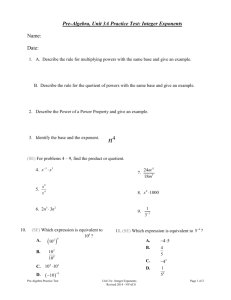Pre-Algebra 8 (2014-15) Unit 01: Rational Numbers and Decimal
advertisement
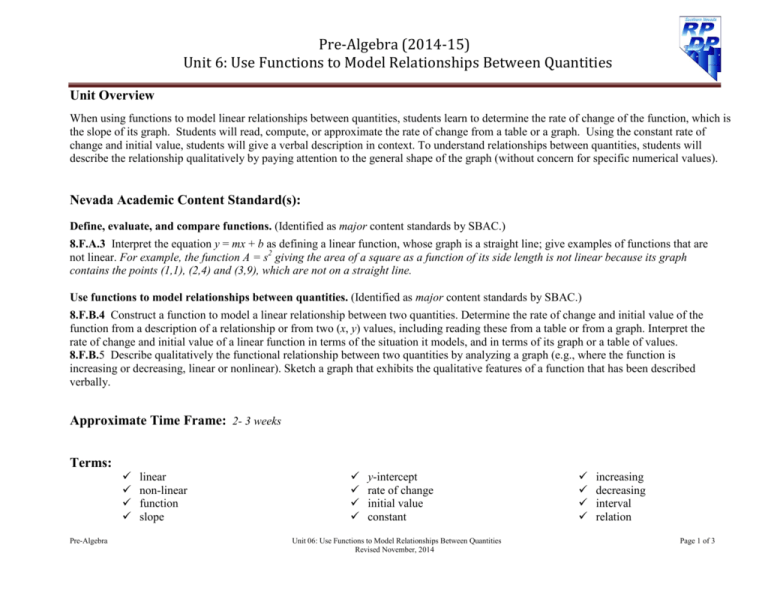
Unit Overview Pre-Algebra (2014-15) Unit 6: Use Functions to Model Relationships Between Quantities When using functions to model linear relationships between quantities, students learn to determine the rate of change of the function, which is the slope of its graph. Students will read, compute, or approximate the rate of change from a table or a graph. Using the constant rate of change and initial value, students will give a verbal description in context. To understand relationships between quantities, students will describe the relationship qualitatively by paying attention to the general shape of the graph (without concern for specific numerical values). Nevada Academic Content Standard(s): Define, evaluate, and compare functions. (Identified as major content standards by SBAC.) 8.F.A.3 Interpret the equation y = mx + b as defining a linear function, whose graph is a straight line; give examples of functions that are not linear. For example, the function A = s2 giving the area of a square as a function of its side length is not linear because its graph contains the points (1,1), (2,4) and (3,9), which are not on a straight line. Use functions to model relationships between quantities. (Identified as major content standards by SBAC.) 8.F.B.4 Construct a function to model a linear relationship between two quantities. Determine the rate of change and initial value of the function from a description of a relationship or from two (x, y) values, including reading these from a table or from a graph. Interpret the rate of change and initial value of a linear function in terms of the situation it models, and in terms of its graph or a table of values. 8.F.B.5 Describe qualitatively the functional relationship between two quantities by analyzing a graph (e.g., where the function is increasing or decreasing, linear or nonlinear). Sketch a graph that exhibits the qualitative features of a function that has been described verbally. Approximate Time Frame: 2- 3 weeks Terms: Pre-Algebra linear non-linear function slope y-intercept rate of change initial value constant Unit 06: Use Functions to Model Relationships Between Quantities Revised November, 2014 increasing decreasing interval relation Page 1 of 3 Unit 6: Use Functions to Model Relationships between Quantities Construct Functions Write Linear Equations 8.F.B.4 SBAC Evidence: The student constructs a function to model a linear relationship between two quantities. The student determines the rate of change and initial value of a function, either from a description of a relationship or from two (x, y) values, including reading the rate of change and/or the value of the function from a table or a graph The student interprets features of a linear function, such as rate of change and initial value, in terms of the situation it models, its graph, or a table of values. ML – McDougal Littell, Pre-Algebra Book; Larson, 2005 EX – Explorations in Core Math (Holt McDougal) IL – Illinois Model Math Curriculum NY – Engage New York MAP – Math Assessment Project (MARS) Linear vs Non-Linear Functions 8.F.A.3 Pre-Algebra SBAC Evidence: The student recognizes and gives examples of functions that are not linear. KEY Pre-Algebra (2014-15) Unit 6: Use Functions to Model Relationships Between Quantities EX 8-1 Graphing Linear Equations (page 295) EX 8-3 Using Slopes and Intercepts (page 305) EX 8-4 Point-Slope Form (page 313) IL Lesson 3: Constructing Functions IL 8F4 Activity: Function Matching Rice.edu Lesson: Fun & Sun Rent-A-Car NY Module 6 Lesson 1: Modeling Linear Relationships NY Module 6 Lesson 2: Interpreting Rate of Change and Initial Value NY Module 6 Lesson 3: Representations of a Line Learn Zillion Lesson Plan: Interpret initial value and rate of change in terms of the situation it models Learn Zillion Lesson Plan: Determine rate of change and initial value from a table by examining values in the table Learn Zillion Lesson Plan: Determine rate of change and initial value from a graph or an equation by inspection Learn Zillion Video Lessons: Construct functions, determine slope and initial value, and interpret in terms of a situation NC Lessons for Learning (page 29): Bow Wow Barkley NC Lessons for Learning (page 45): Sandy’s Candy Corporation ML 12.6 part of Quadratic Functions (page 680) EX 9-3 Linear Functions (page 355) IL Lesson 2 Segment 2: Linear and Non-Linear Functions Learn Zillion Video Lessons: Interpret the Equation y = mx + b as defining a linear Function Learn Zillion Video Lessons: Interpret the Equation y = mx + b Unit 06: Use Functions to Model Relationships Between Quantities Revised November, 2014 Page 2 of 3 Pre-Algebra (2014-15) Unit 6: Use Functions to Model Relationships Between Quantities Learn Zillion Video Lessons: Describe the rate of change of a linear function Illustrative Math Task: Introduction to Linear Functions NY Module 5 Lesson 8: Graphs of Simple Non-Linear Functions NC Lessons for Learning (page 36): Nonlinear Functions FL CPALMS Lesson: Functions: Are They Linear or NonLinear? Qualitative Graphs 8.F.B.5 Pre-Algebra The student qualitatively describes the functional relationship between two quantities by analyzing a graph (e.g., whether the function is increasing or decreasing, or whether the graph is linear or nonlinear.) The student draws a graph that exhibits the qualitative features of a function that has been described in writing. EX 2-3 Interpreting Graphs (page 55) MAP: Interpreting Distance-Time Graphs PBS Learning Media: Location Graphs NY Module 6 Lessons 4-5: Increasing and Decreasing Functions Directions and videos to use: Graphing Stories NC Lessons for Learning (page 53): The Case of the Vase Unit 06: Use Functions to Model Relationships Between Quantities Revised November, 2014 Page 3 of 3

